January 1998
Vol. II. No. 4
Intellectuals endorse NSKRI agenda for
preservation of Kashmiri Pandit culture and heritage
In what can be described as a meaningful
interaction, intellectuals, scholars, writers and social and cultural workers of
the Kashmiri Pandit diaspora in Delhi signalled their approval of the programmes
chalked out by N.S. Kashmir Research Institute for the community's survival as a
distinct social and cultural entity. At a meeting called by NSKRI on the 55th
death anniversary of Pandit Nityanand Shastri on December 21,1997 in New Delhi
to share with them its perceptions on the post-exodus cultural predicament of
the Pandits, they paused and pondered over the points put forward by the
Institute, overwhelmingly endorsing its stand.
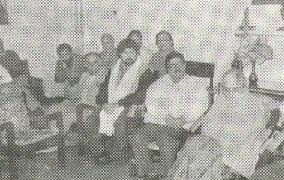
Giving a background of the situation into
which this numerically small but culturally significant community has been
pushed into by "cataclysmic events" triggered by the
"fundamentalist fury of Islamist terrorism" in Kashmir in the recent
years, Dr. S. S. Toshkhani, of the NSKRI core group observed: "That a
people who have contributed so richly to the cultural and literary traditions of
the country are today facing the most sinister threat to their identity is
perhaps the greatest tragedy of post-independence India." He lamented that
the community itself was drifting away from its cultural roots "at a pace
too fast for comfort" while facing the exigencies ofthe present situation.
"A state of amnesia seems to be
overtaking us about our traditions and heritage, our attainments in the fields
of learning, literature, aesthetics and philosophy," he added," so
much so that Abhinavagupta and Anandvardhana, Utpalacharya and Somananda,
Kalhana and Bilhana, Kshemendra and Somadeva, why even the great Lalleshwari are
today for most of us nothing more than shadows from a forgotten past."
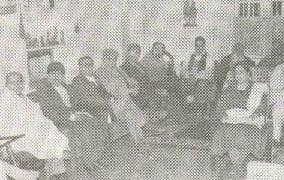
Dr. Toshkhani said that it was agonising
that priceless treasures of Kashmiri Pandit heritage - old manuscripts,
paintings, pieces of art - have been irretrievably lost or irrepairably damaged
as a result of the fundamentalists depredations and our own unconcern. What is
still left - lies scattered in a state of callous neglect.
Realizing the disastrous dimensions of
these tragic developments, a group of concerned community members felt the
imperative need to save and sustain a culture in exile, so vitally important for
giving a meaning to their existence, through a collective and concerted drive at
an organised and institutional level. "Not only have all-out efforts to be
made to salvage and snatch back whatever is possible from the jaws of time, but
also a bulwark has to be built against sinister onslaughts seeking to destroy
the Pandit identity", Dr. Toshkhani pointed out, refering to the
circumstances in which the N.S. Kashmir Research Institute took its birth on
January 19,1997. The Institute has been since engaged in drawing up parameters
for the study of the factors defining and determining this identity, seeking to
"explore and bring to light areas and territories so far unmapped and
undiscovered in Kashmiri culture, art, aesthetics, language, religion, rituals,
philosophy, folklore and allied fields," as put forth in the Institute's
introductory brochure.
Heritage Centre
Dr. S.S. Toshkhani presented on behalf of
NSKRI, a brief outline of the programmes and tasks the Institute is thinking of
undertaking in pursuance of its objectives. The Institute shall e'ndeavour, in
the first place, to procure, preserve and document materials relating to
Kashmiri Pandit culture and heritage available from all possible sources in the
form of manuscripts, books, miniature paintings, sculptures, inscriptions,
photographs, artefacts, documents etc. with the ultimate aim of setting up a
heritage centre in Delhi which can be used for reference and research purposes
by all those interested in Kashmir studies. The task of documentation,
preservation, collation, compilation and display of such materials shall be
entrusted to experts in the field well-versed in modern methodologies.
Exhibitions
Thematic exhibitions on various aspects of
Kashmiri Pandit culture and heritage shall form an important feature of NSKRI's
activities. Work on mounting the first of sueh exhibitions, likely to be held
towards March end '98, is in full swing. The exhibition shall have various
sections covering Kashmiri Pandit culture, traditions, customs and creative and
artistic attainments. Sharda and Persian manuscripts, miniature paintings,
artefacts, costumes, folk art and other items of cultural, civilisational and
ritual significance will be on display besides old photographs depicting the
Kashmiri Pandit way of life.
Search for manuscripts and miniature
paintings
The Institute plans to launch an extensive
search for Sharada manuscripts and miniature paintings of the Kashmir school.
Details of the tour programme NSKRI scholars propose to undertake for this
purpose are to be worked out and will be finalised soon after the cultural
heritage exhibition to be organised by the Institute is over. The quest is
likely to take them to different places in the country and also, possibly,
abroad.
Quarterly Research Journal 'Spanda'
'Spanda', a quarterly research journal, is
being launched by the Institute, featuring well researched articles on various
subjects related to Kashmiri Pandit cultural and literary heritage and shedding
light on the community's attainments in different fields of intellectual and
artisic activity. The first issue of the journal is under compilation and is
expected to be brought out in about two or three months.
Album of Kashmiri Miniatures
Another top priority item on the agenda of
NSKRI is the compilation of the first ever album of Kashmiri miniature
paintings. No systematic study of the Kashmiri school of art has been attempted
so far and no one has ventured to prepare an album of these miniatures,
notwithstanding their importance in the overall context of the history of Indian
art, the Kangra and Pahari styles being but offshoots of this precious school of
art. While a large number of such paintings have been lost - sold by their
unscruplous owners or others to foreigners and private art collectors in the
country in a most callous manner, the Institute has managed to acquire about two
dozen Kashmiri miniature paintings and is in the process of acquiring more. The
album will be published with an introduction and critical assesment of
individual paintings included in it.
Publications Programme
NSKRI is embarking upon an ambitious
publications programme to project Kashmir Pandit literary and cultural
attainments in new details and dimensions, shedding light on hitherto untouched
aspects and uncovered areas. Of the works that are to be taken up for
publication, several are already in different stages of preparation.
Encylopaedia of Kashmiri Culture
A major project which the Institute is
contemplating to start is the compilation of an encyclopaedia of Kashmiri
culture designed to cover the entire gamut of Kashmir's indigenous cultural,
artistic, philosophical, spiritual and literary traditions - a vast canvas
indeed. A pioneering project of gigantic proportions, the encyclopaedia will
have illuminative enteries from competent experts together with photographs and
illustrations. Besides philosophy, religion and literature, the contents will
include topics related to creative and performing arts like music, dance, folk
and classic theatre and other relevant fields. Top ranking scholars will be
involved in the project and requested to prepare an exhaustive synopsis of the
probable contents.
Critical Editions of Classics
Critical editions, with introduction,
notes and comments, of some classics of Kashmiri literature will form yet
another important feature of the NSKRI publication programme. Work on Vakhs of
Lalleshwari, Kashmiri Ramayana, poetic works of Krishna Joo Razdan, will be
taken up in the first phase.
Biographical Sketches of Scholars
This series shall include monographs
portraying life and work of eminent Kashmiri scholars like Nityanand Shastri,
Govind Kaul, Madhusudan Kaul Shastri, Mukund Ram Shastri, Anand Kaul, Ishwar
Koul, Sahaz Bhatt, Swami Lakshman Joo, Prof. Jagaddhar Zadoo and Prof. S.K.
Toshkhani. Portraits of these scholars are already being prepared by a young and
upcoming artist, Sunil Handoo. The idea is to revive the memory of those of whom
the community can feel proud for their outstanding contributions in the field of
scholastic endeavour.
Seminars and Symposia
Seminars, symposia, conferences and
discussions on various subjects pertaining to Kashmiri Pandit culture and
heritage will be organised from time to time as an important activity of the
Institute.
Other Publication Projects
Books introducing Kashmir Shaivism, Shakta
philosophy, besides tracts and booklets on Kashmiri Pandit religious practices,
rituals, places of pilgrimage etc. shall also form part of NSKRI's publication
programme.
NSKRI is fully aware of the enormity of
the tasks and goals it has ventured to pursue, Dr. Toshkhani said, but its
efforts could well take the shape of a movement calling for the involvement of
everyone concerned about the predicament of the Kashmiri Pandit community.
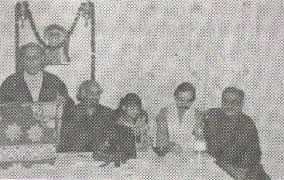
Sh. P. N. Kachru speaking at the intellectuals' meeting
The NSKRI agenda for protection,
preservation and projection of Kashmiri Pandit culture, heritage and traditions
drew tremendous response from the participants who had come from all parts of
Delhi and its satellite towns.
Among those who took active part in the
discussions were Dr. Susheela Bhan, Dr. B.N. Kalla, Shri Virendra Bangroo, Shri
S. J. Raina, Shri Brij Lal Kaul Chaman, Shri L. C. Kaul, Shri Virendra Qazi, Dr.
Aloke Kalla and Shri Susheel Pandit.
Apart from these, Prof. H. K. Kaul, Prof.
Subhash Razdan, Capt. S. K. Tikoo, Col. O. N. Razdan, Shri K. S. Raina and Smt.
Veena Pandita also participated in the meeting.
An interesting feature of the meeting was
the presence of a number of non-Kashmiri intellectuals who enthusiastically
participated in its deliberations which lasted for several hours. These
included: Padmashree & Smt. G.B.Meemamsi, Shri N.S. Chakarvarti Dr. &
Smt. Uday Kant Mishra, Shri S.P. Punj and Shri Bal Krishna Bhatt.
Speaking on behalf of the NSKRI core
group, eminent Kashmiri artist, P.N. Kachru fervently appealed to the
participants to understand the exigencies of the situation and come forward to
help the Institute in salvaging and collecting cultural and heritage material.
Forgetting the intellectual and
philosophic gymanstics, we want to preserve in whatsover form available relevant
material pertaining to our culture - painting, art pieces, artefacts and such
other items", Shri Kachru said, emphasizing that it is the Kashmiri Pandit
heritage that is most representative and most valuable in the context of
Kashmiri culture. It is this foundation that is sought to be dismantled he
lamented, refering to the situation created by terrorist violence and asserting:
"We want to keep this foundation strong, for on it alone will any
superstructure stand."
Supply to us whatever is possible, even if
it be some reference or piece of information regarding heritage material, if not
the actual items", he said. "Photographic evidence of the Kashmiri
Pandit way of life would also be welcome", he added, refering to the
forthcoming cultural heritage exhibition that NSKRI is organising. " You
can loan these items to us for the purpose of the exhibition if you feel any
hesitation in gifting them to the Institute", Shri Kachru appealed.
"We want to preserve them,document them for history", he went on to
say, " whether it be a piece of art, or a piece of literature, or any find
of some value. Even small items need to be preserved and documented. That is
what the Institute is all about."

Sanskrit speeches win big applause at
NSKRI intellectuals' meet
As if to underline the link between
Sanskrit learning and Kashmir, several speakers at the intellectuals' meeting
called by NSKRI on December 21,1997, spoke in Sanskrit. These speeches charmed
the audience, who not only received them well but appeared to be swept by them,
understanding easily and lapping eagerly every word spoken, contrary to the
impression sought to be created by some that Sanskrit is a difficult and dead
language. The effect was indeed tremendous, the speakers winning thunderous
applause while expressing their views.
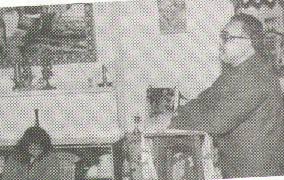
Shri C. V. Gopinath delivering his Sanskrit speech
C.V.Gopinath, an eminent scholar from
Karnataka and a high officer in the telecommunications department, set the tone
for eloquence in the country's cultural lingua franca and recalled the great
reverence in which Kashmir has been held throughout India for its outstanding
contribution to Sanskrit language and literature.
He referred to the famous first line of
the Sharda Stotram: "Namaste Sharada Devi Kashmira Puravasini", which
he said he had heard as a child from his mother. Answering his querry, his
mother had explained that Sharda, the Goddess Saraswati, was said to reside in
Kashmir as that land had been a great centre of learning and had the same place
in the country that head has in the human body.
The Pandits of Kashmir, Shri Gopinath
said, held a sway in the past over various branches of knowledge like poetics,
ethics, philosophy, prosody and other subjects studied in ancient India.
"Who does not know of the works of literary giants like Mammata, the author
of Kavya Prakash, or the world famous Kalhana, who wrote "Rajatarangini",
he asked, referring to the outstanding attainments of Kashmiri Pandits which
hold a pride of place in Sanskrit literature. Praising the Kashmiri Pandit
culture and intellectual tradition, he said that Kashmir has indeed blazed a
glorious trail as a repository of ideas and values. "Hail Kashmiri Pandit
culture! Hail India!" he exclaimed, concluding amidst cheers.
Shri Balkrishna of Sanskrit Bharati
another eminent scholar from Karnataka whose mission is to popularise Sanskrit
in the country and abroad and who even in ordinary conversation makes it a point
to express himself in Sanskrit, said that Kashmir was linked to India mainly
through Sanskrit, of which it has been a great centre in the past.
"Kashmiri Pandit parampara (tradition) minus Sanskrit is zero", he
said emphasizing his point and recalling the peaks of glory that stalwarts of
Sanskrit literature produced by Kashmir, like Abhinavagupta, Anand Vardhana,
Kalhana and others, had attained. The Pandits, he said, shall have to go back to
the Sanskritic roots of their culture and tradition if they want to regain their
past glory.
Dr. B.N.Kalla, a well known Kashmiri
scholar, also eulogised the contribution of Kashmiris to Sanskrit, refering to
great names like Abhinavagupta, Ananda Vardhana, Bhatta Kallatta, Mammata,
Utpalacharya, Somadeva, Kalhana, Bilhana and Kshemendra to stress their
brilliant achievements in the fields of literature, aesthetics and philosophy.
He quoted the popular verse of Bilhana, "Sahodaram kunkuma kesaranam",
which testifies to the verstality of Kashmiris in the literary field, claiming
that even women and cooks are engaged in composing poetry in Sanskrit and
Prakrit in his native land. Paying tributes to Pandit Nityanand Shastri, Dr.
Kalla said that he shared his place of glory in the grove of academe with other
great scholars like Pandit Harbhatta Shastri, Pandit Madhusudan Shastri, Pandit
Mukundram Shastri and other stalwarts.

Glowing Tributes paid to Pandit Nityanand
Shastri
Scholar extraordinaire, Pandit Nityanand
Shastri was remembered with profound respect and immense admiration on his 55th
death anniversary which fell on December 21, 1997. Homage in glowing terms was
paid to his memory at a special function organised by NSKRI on the day in New
Delhi with speaker after speaker hailing him as a symbol of the scholastic
renaissance in Kashmir in the early decades of the present century.
Speaking on the occasion, S.N.Pandita a
member of the NSKRI core group, who also happens to be the youngest grandson of
the great Sanskrit scholar, said that while offering his respectful homage to
him he was paying tribute not to Pandit Nityanand Shastri alone as an individual
for his extraordinary scholastic attainments, but to the "whole galaxy of
great Kashmiri scholars" that the age threw up and whose spirit of "perserverence,
dedication and excellence" he represented." He seems to be a
representative of that ethos, that sensitivity of a community" towards
cerebral graces that he and his contemporaries like Pandit Harbhatta Shastri,
Pandit Madhusudan Shastri, Pandit Ishvar Kaul and others shared, Shri Pandita
said.
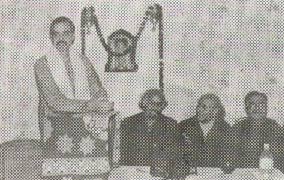
Shri S. N. Pandita paying homage to Pandit Nityanand
Shastri
"Reflecting the Kashmiri Pandit mind,
NS had respect for knowledge ingrained in him as one of the main traits of his
character. Throughout his life he made it a point to go round the house of the
master at whose feet he learnt, Pandit Damodar, making parikarma of it as the
first thing in the morning", Shri Pandita added.
And in turn, the cream of Western
Sanskritists of that age - Straton, Stein, Grierson, Edgurton, J.Ph Vogel,
Vereese, Hobbart Winternitz ‹ had developed a unique respect for NS for his
great learning.
Through NS, S.N. Pandita said, he was
actually paying homage to all the stalwarts of his time - great Kashmiri men of
learning whose interface with Western scholars led to an amazing exploration and
re-interpretration of Kashmiri literary tradition.
Equally eloquent was the tribute to NS by
C.V. Gopinath, an eminent scholar from Karnataka who, choosing to speak in
Sanskrit, described him as "Pandit Shiromani" and a "KarmaYogi"
dedicated selflessly to the service of knowledge. Shri Gopinath referred to the
immense respect in which European scholars held NS, acknowledging the stunningly
vast range of his erudition. Expressing his happiness at NSKRI having been named
to honour the memory of the profound Kashmiri scholar, he expressed the hope
that the Institute would successfully pursue its objective of preserving the
Kashmiri Pandit cultural tradition.
Shri Balkrishna, of the Sanskrit Bharati,
Delhi, also praised NS for his outstanding services to Sanskrit, and so did Dr.
B.N.Kalla, well known Sanskrit scholar from Kashmir. Both the scholars offered
their tributes in Sanskrit like Shri C.V.Gopinath.
But, perhaps, what won everybody's heart
in the audience were the simple lines spoken by litle Apeksha Pandita in
English, tracing her ancestry to Pandit Nityanand Shastri as her
great-grandfather.

"NSKRI has alerted cultural defence
mechanism to safeguard Kashmiri Pandit identity"
- C. V. Gopinath
"The rich Kashmir Pandit culture has
been subject to onslaughts from time to time, century after century, yet its
special significance lies in the fact that it has still been retained in the
original form and content", said eminent scholar CV Gopinath while
delivering a scintillating speech on culture and defence mechanism at the
intellectual's Meeting organised by NSKRI.
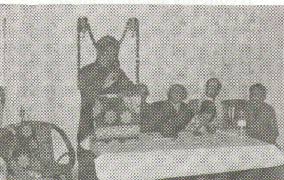
An interesting feature of the meeting was
the participation of a good number of non-Kashmiri intellectuals in its
discussions, including Shri Gopinath who extended hospitality to the
participants. These non-Kashmiri intellectuals, mostly from South India,
expressed their deep admiration for the Kashmiri Pandit community. For its
immense contribution to Sanskrit and Indian culture.
"History will tell you Shri Gopinath
explained, " that whenever there is an onslaught on any culture, the
defence mechanism of that culture has always stood it in good stead."
Emphasing his point, Shri Gopinath said,
"The greatest example of such defence mechanism being alive in the Kashmiri
Pandit community is the birth of N.S. Kashmir Research Institute itself. During
the last one or two decades there has been a lot of disturbance in Kashmir, and
the Kashmiri Pandits have been driven out from their own places, their own
motherland. In such circumstances even the culture defence mechanism tends to
get weakened to loss its strength that is why the Pandits are feeling a great
danger to their identity."
Declaring that Indian culture is
incomplete without Kashmir Shaivism, Kashmiri cultural and literary tradition,
Shri Gopinath assured the Kashmiri intellectuals concerned about retaining their
cultural identity outside their native land that "India's defence
mechanism" was there to protect them. "We are all here to see that we
safeguard your identity, because in your identity lies our identity", he
said amidst thunderous applause.

PERSONALITY
Mahamahopadhyaya
Pandit Mukund Ram Shastri
A collosus among scholars
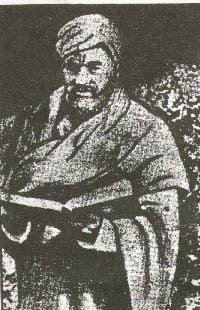
Pandit Mukund Ram Shastri
[From archaeology and paleography to
Kashmir history to Kashmir Shaivism to grammar and literature Mahamahopadhyaya
Pandit Mukund Ram Shastri (MRS) strode like a colossus in almost every field of
Kashmir studies at the turn of the 19th century and in the early years of the
twentieth. Gifted with unusual brilliance, MRS worked with Western scholars of
the times like Aurel Stein, Sten Konow, Spooner, Prof. Hiltzch, Pope Ved, John
Marshal and George Grierson, helping them with his outstanding erudition and
intellectual abilities and winning fulsome acclaim from them. His name inspired
tremendous respect in academic circles in India and Europe, making John Marshall
to say: " There is no Pandit in India of whom I have heard such consistent
and such high praise from all with whom he came into contact. "]
Mahamahopadhyaya Pandit Mukund Ram Shastri
was an extraordinarily gifted Pandit of Kashmir whose extensive knowledge and
vast erudition won him a dazzling place in Pan-Indian, and even in European,
scholastic circles. In fact, his name became a legend during his lifetime,
evoking feelings of respect and admiration in scholars of even the highest
order.
Born to Kashmiri Pandit parents, Pandit
Ganesh Bhatt Ganjoo and Amravati, in the Sathu Barbarshah locality of Srinagar,
Pandit Mukund Ram had his early education at the local Sanskrit Pathshala under
the tutelage of Pandit Daya Ram Kaul. He acquired the degree of Shastri, then a
covetted degree for those who went in for Sanskrit studies, from Punjab
University, Lahore. Shastri became an inseparable part of his name thereafter.
Soon the young Shastri found himself
translating Persian and Arabic books into Sanskrit under the supervision of
Pandit Ramjoo Dhar, which brought him into limelight in the world of Sanskrit
academics. This prompted Ranbir Singh, the Maharaja of Jammu and Kashmir state,
to offer him the prestigious assignment of translating a Tibetan Buddhist
treatise "Kangur and Tangur" into Sanskrit. Learning Tibetan from
Thomas Tamsel, MRS completed the stupendous task of translating the 1,50,000
verses with great competence and ability. This enhanced further his reputation
as a scholar and earned him a cash award of Rs.500 - quite a huge sum those
days.
Impressed, the Maharaja asked MRS to
accompany Lama Gure to Paddar in Kashtwar. Kashmir, where the latter had to
conduct research on sapphires in which the area is rich. It was here that he
came into contact with the well-known European orientalist Pope Ved, who was
engaged at that time in preparing a book on Kashmiri grammar. MRS assisted Ved
with great ability, displaying a deep study of Kashmiri syntax and grammatical
forms. Soon afterwards MRS was appointed as Sanskrit teacher at CMS Biscoe
School, Srinagar, a school run by Christian missionaries, but gave up the job on
the request of Aurel Stein who arrived in Kashmir in the year 1899 for
translating the Rajataringini. MRS assisted Stein in several ways till his great
work was completed. It was on Stein's recommendation that MRS helped Grierson
while he was engaged working on his linguistic survey of India. Thus began his
two decade association with Grierson which saw publication of works like the
dictionary of the Kashmiri language and an annotated translation of Krishna joo
Razdan's "Shiva Parinaya."
On the request of A.W. Straton, who was
Registrar Punjab University, Lahore from the years 1900 to 1902, MRS wrote
"Katak Bhasha Sutra", a work of great value.
As was natural, when the Research
Department was set up by the Maharaja's government in 1912, MRS was chosen as
its Head Pandit. Later, he rose to the position of Officer Incharge, Research
and Archaeological Department, a post he held till 1919.
In 1908, MRS worked closely with Sten
Konow, Epigraphist to Government of India, and David B. Spooner, Superinten-
dant Archaeological Survey. MRS was a great help to A.M Francki during the
latter's archaeological explorations in Ladakh-Tibet border, in deciphering
Sharada and Devanagari inscriptions. Wrote Francki, who was senior
Archaeologist, Government of India "The Dras inscriptions which had been
given up in despair by Sir William Cunningham became perfectly intelligible
under the treatment of Mukund Ram Shastri. This gentleman has extra- ordinary
ability to decipher and interpret inscriptions in Sharada and Devanagari which
are in bad state of preservation."
During the years 1903 to 1907, MRS worked
on ancient history of Kashmir and ably assisted Spooner in his work on
Jonaraja's "Jaina Rajataringini", which covers Sultan Zain-ul-Abidin's
period. He also proved of immense help to Sir John Marshall in his
archaeological explorations in Kashmir. But perhaps the finest hour in MRS' life
was when he critically edited a whole series of texts on Kashmir Shaivism during
his tenure in the Research Department of Jammu and Kashmir. Of the 29 books
brought out by the Department under the title "Kashmir Series of Texts and
Studies", as many as 23 were edited by MRS, including "Shiva Sutra
Vimarshini", "Spanda Karika", "Tantraloka", "Tantrasara",
"Ishwar Pratibijnya", "Paratrimshika" and "Parmarthasara".
This series of Shaiva texts is perhaps a monumental accomplishment of the great
scholar for which his name shall be ever taken with pride and. profound respect.
MRS also edited and published "Mahanaya
Prakash" one of the earliest extant works in Kashmiri.
Apart from these texts, the compilation
and translation of Lalla Dyad's verses under the title " Lalavakyani"
by George Grierson and L.D. Barnelt in 1920 also owes much to the labours of MRS,
who also helped Grierson in editing the "Kashmira Shadamrita" by
Ishwar Kaul.
With such brilliant attainments to his
credit it is no wonder that the title "Mahamahopadhyaya" was conferred
upon MRS in recognition of his profound knowledge of a vast range of subjects
fromSanskrit language and literature and philosophy to grammar and epigraphy.
MRS left his mortal frame in 1921, leaving
behind the imprint of his genius. on his great works of scholarship.
To his Western counterparts he was a
kindred spirit. Grierson called him his "old friend". Stein observed:
"I shall always be glad to remember him among my friends". Dr. Hutzch
records "In him also I hope to have found at once a friend whom I shall
never forget". To all those for whom Kashmir is not just a geographical
denomination but a repository of learning and ideas, MRS will ever, remain a
guiding star.

Mahabharata Manuscripts from Kashmir in
Prague
The critical edition of the Mahabharata
brought out by the Bhandarkar Oriental Research Institute, Pune and edited by P.
L. Vaidya is largely based on two Sharada manuscripts of the epic from Kashmir.
When Prof. Maurice Winternitz of Prague University published his "
Mahabharata - the Great Epic of India " in 1925, he too relied on Sharada
manuscripts with commentary by Nilakantha, which were found to be more
authentic. Not only this, Prof. Winternitz took much help in compiling and
completing this work from Prof. Nityanand Shastri.
These Sharada manuscripts, however, were
sent out of Kashmir between the years 1923 and 1924. No details are known about
these manuscripts since they are lying in the Library of Prague University of
the present day Slovakia, which was earlier known as Czechoslovakia. It is not
known whether any copy or micro-film of these valuable Mahabharata manuscripts
is available in India, but NSKRI shall make efforts to trace them out and obtain
a copy from the Prague University. Meanwhile a translation of the full epic in
Kashmiri prose by Pandit Suna Ram Razdan is lying with J&K Cultural Academy
has still to see the light of the day. The manuscript, purchased by the Academy
has one thousand octavio sized pages.
Manuscript of a verse translation of the
Mahabharata is lying with the University of Kashmir. A portion from it was
published by the Sahitya Akademi in 1959.

The "Khaat Bazaars" of Amritsar
Interested in a Kashmiri miniature
painting? A Sharada manuscript? An antique piece of sculpture? Step into the
periodic Khaat Bazaars (cot markets) of Amritsar and chances are that you will
find yourself bargaining with footpath peddlers unabashedly putting Kashmiri
Pandit culture on sale - especially if you happen to be a foreigner or even an
Indian art collector and can afford the astronomical price asked for. It is
equally possible that a priceless treasure may be offered to you for a song.
It is not just coincidence that business
in such heritage material started flourishing in the recent years, soon after
the exodus of Kashmiri Pandits from Kashmir. While it is common knowledge that
frenzied groups of Islamist terrorists burnt down or damaged thousands of
Kashmiri Pandit houses, not many know the fact that a large number of their
houses were ransacked and looted, mostly for the property that the fleeing
Pandits left behind but also for more precious items like old manuscripts and
miniature paintings. The more clever and sophitisticated among the looters knew
that these treasure troves could well fetch them a fortune and so they set out
foraging for them from one deserted house to another. Finding a new avenue of
making easy lucre opening up for them, several of then collected old manuscripts
by the kilogram. Some of them must have indeed hit the jackpot! And so while
Kashmir is burning, the plunderers are earning.
Thus it is that several shady business
houses have cropped up in the past seven or eight years in and around Srinagar.
Some of them are acting as fake research
centres, as for example the one that has come up near Nishat, with looted
manuscripts neatly stacked for sale. These "centres" are doing brisk
business. striking deals with collectors. antique dealers and societies. It is
here that the peddlers and scrap-dealers from Amritsar are proving of great
help.
But why take the trouble of longish trip
to on Amritsar Khaat Bazaar? You could easily bump into a dealer in alleys and
lanes of Delhi itself. Their visits from the doomed valley to the country's
capital in search of channels of collectors, agents of antique houses and
organisations, and to make lucrative bargains of the looted possessions, are
getting more and more frequent. Often these people put on a mask of
sophistication while on the prowl, well- versed in the art of entrapping
potential buyers as they are. Their suave behavior makes many fall to their bait
and loosen their purse strings to acquire an old manuscript or a miniature. In a
recent case a birch-bark manuscript in Sharda carrying two miniature paintings
was offered by one such dealer to an arts centre for a whopping rupees one lakh.
As for the Pandits, most of them are
hardly aware of such goings on to be disturbed by the loss oftheir mostvaluable
treasures. The only way to put a stop to such practices is to acquire these
materials at any price possible and preserve them in a heritage centre. NSKRI is
contemplating steps to set up such a centre in Delhisomething which requires
raising of considerable funds. Will members of the Kashmiri Pandit community
come forward and cooperate?

NSKRI offers homage to Pandit Raghu Nath
Kukiloo
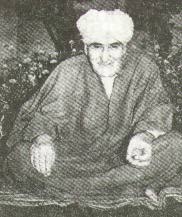
Pandit Raghu Nath Kukiloo
NSKRI deeply condoles the passing away of
Pandit Raghu Nath Kukiloo - saint, scholar and astrologer of great reputation
popularly known as "Baigaash". The news of his sad demise was received
with great shock by the exiled Kashmiri Pandit community which is already
reeling under the impact of losing two of its best known scholars, Prof P. N.
Pushp and Pandit Janki Nath Kaul 'Kamal' in just one year or so.
The end came on December 23, 1997 at about
3 P.M. when Pandit Kukiloo had just finished distributing Prasaad among devotees
and disciples after his daily worship and had hardly taken a morsel or two of
his lunch, according to "Maalini", the quarterly journal of
IshwarAshram Trust, Ishber, Srinagar. Suddenly, says the journal, he felt the
divine effulgence of Kundalini engulfing him. Trying to address the divine
presence, he went into a trance from which he never woke up. Pandit Raghu Nath
Kukiloo has, however, left behind him his hallowed memories for the host of his
disciples and admirers in the community who looked to him for guidance in
spiritual as well as mudane matters. They regarded him as a great yogi, an
erudite scholar and a master of astrology gifted with the extraordinary power of
clairvoyance.
Born in a scholarly family in the
Banamohalla locality of Srinagar in the year 1911, the widely respected Pandit
was spiritually inclined from childhood. A Shakta by faith, he was a devotee of
the Goddess Tripurasundari When in Srinagar he would never miss the daily
Parikrama (circumambulance) of Sharika Devi at Hari Parvat, according to Shri
R.C. Kaul Pamposh an old discipie of Pandit Kukiloo. While he had fathomed the
depths of the Shakta philosophy of Kashmir, which he would interpret in his own
unique manner, Pandit Kukiloo's understanding of the Vedantic and Shaiva
philosophies was equally profound. He was known for his performance of the
annual Pancharatra puja on the occasion of Mahashivaraatri.
Pandit Kukiloo is said to have had a close
association with the great Shaivaacharya of Kashmir, Swami Lakshman Joo. Swamiji
would make it a point to obtain the blessings of Pandit Kukiloo on his birthday,
showing in what high esteem he held him.
Pandit Raghu Nath was a sensitive soul who
was moved by the sufferings of the people which he tried to mitigate in his own
way through the methods of astrology. The number of people who believed that he
could divine the future through accurate astrological predictions was legion,
the Pandit having become a living legend in Kashmir. But what endeared him to
everyone was his readiness to make himself available to the elite and the
commoner alike for consultation and help.
Like hundreds of thousands of his
suffering community men, Pandit Kukiloo was forced to leave Kashmir in 1990
under the terrorist threat and take residence at Jammu where he continued with
his scholarly and spiritual occupations at 29, Ashok Nagar till his last breath.
While conveying its heartfelt sympathies
to the bereaved members of his family, NSKRI joins the entire Kashmiri Pandit
community in paying its humble homage to the departed saint and scholar.
|